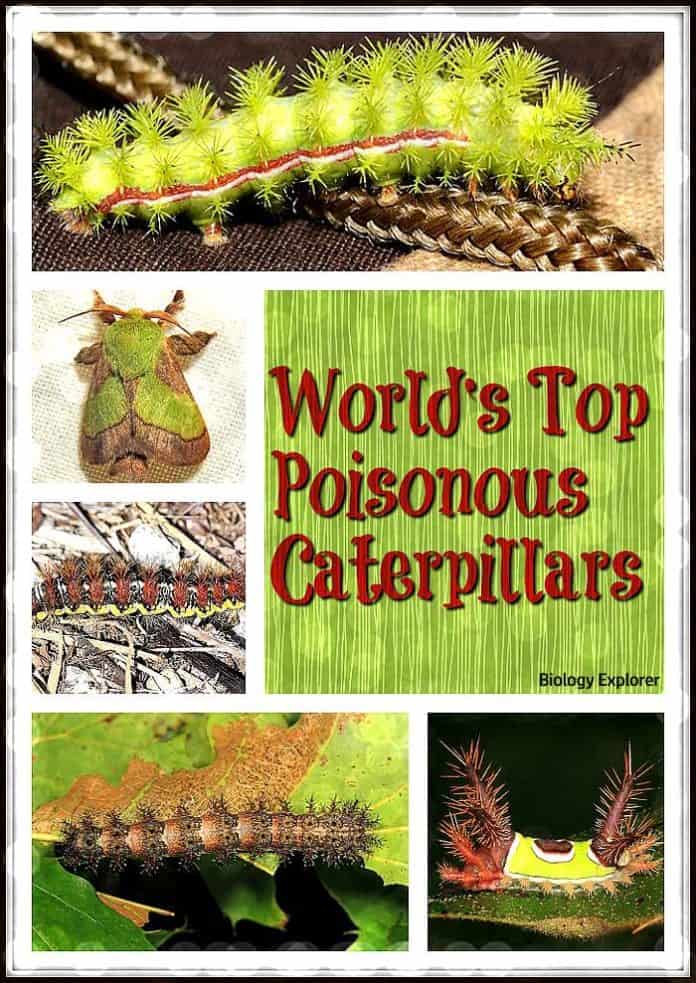
Poisonous Caterpillars: As spring comes to the forests and meadows, and everything is painted green, we may eagerly await the blooming season. The pleasant aroma of flowers brings bright-colored butterflies to meadows and gardens. However, there is a downside to this: butterflies cannot appear without getting through the caterpillar stage.
Table of Contents
- How do caterpillars become poisonous?
- Poisonous Caterpillar vs. Venomous Caterpillar
- Top 15 Poisonous Caterpillars
- Buck Moth Caterpillar (Venomous)
- Saddleback Caterpillar (Poisonous)
- Monkey Slug Caterpillar/Hag Moth Caterpillar (Poisonous)
- Hickory Tussock Caterpillar (Poisonous)
- Southern Flannel Moth Caterpillar or Puss Caterpillar (Poisonous)
- Spiny Oak Slug Moth Caterpillar (Venomous)
- Io Moth Caterpillar (Venomous)
- White Flannel Moth Caterpillar (Poisonous)
- Stinging Rose Caterpillar (Venomous)
- American Dagger Caterpillar (Poisonous)
- Smeared Dagger Moth (Poisonous)
- Laurelcherry Smoky Moth (Poisonous)
- Variable Oakleaf Caterpillar (Poisonous)
- Pine Processionary Caterpillar (Poisonous)
- Giant Silkworm Moth Caterpillar (Poisonous)
- Does a caterpillar being poisonous really help it?
Those worm-like creatures are, in a way “butterfly kids“. They exist to feed on the leaves, grow, make cocoons, and provide enough energy for a future butterfly. Caterpillars are usually not very well-liked.
After all, they eat leaves – and thus destroy plants. However, some caterpillars are not just a nuisance. They can be pretty dangerous for those who try to touch them or to eat them.
Gardeners may hate caterpillars because they destroy fruit trees and bushes, but many animals love to eat them. Caterpillars have to be wary of multiple predators. They employ various protective strategies to avoid being eaten!
For example, their coloring can allow them to hide in plain sight through camouflage. Different species form colonies. However, we shall now discuss a third, much more daring survival strategy.
Several caterpillars develop chemical warfare – they become poisonous. Moreover, some have developed poisons that can kill a human.
How do caterpillars become poisonous?
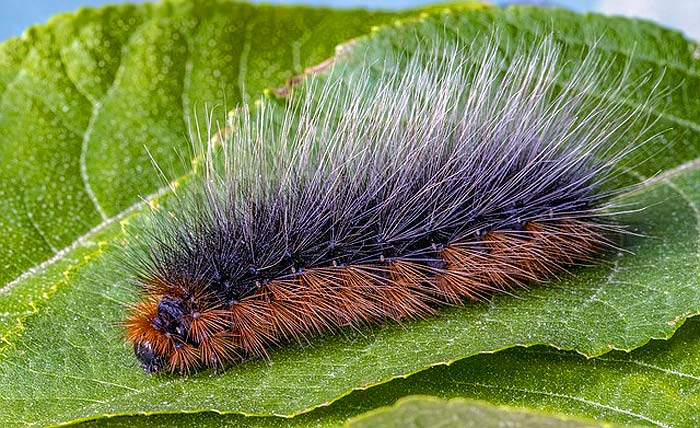
There are several methods the insects can use to become poisonous.
- Some caterpillars feed on poisonous plants like milkweed and store poison inside; others leak acids.
- However, the most dangerous caterpillars have developed detachable weapons containing potential chemical warfare.
- The latter group is quite numerous, and one can find caterpillars with stinging hairs in the Americas, Europe, and Australia.
![]()
Poisonous Caterpillar vs. Venomous Caterpillar
A poisonous caterpillar will harm you if you touch, breathe, or consume it due to the toxic substance it carries. On the other hand, a venomous caterpillar injects a toxin or poison through a sting. So, in the following list of caterpillars, we have marked the venomous vs. poisonous kind.
![]()
Top 15 Poisonous Caterpillars
There are many kinds of poisonous caterpillars. One can find them in almost every place on the planet, except probably the South and North Poles. North and South America are exceptionally lucky (or unlucky) in this regard: one can meet more than 15 species of poisonous caterpillars there, and the ones in South America are considered extremely dangerous.
Buck Moth Caterpillar (Venomous)
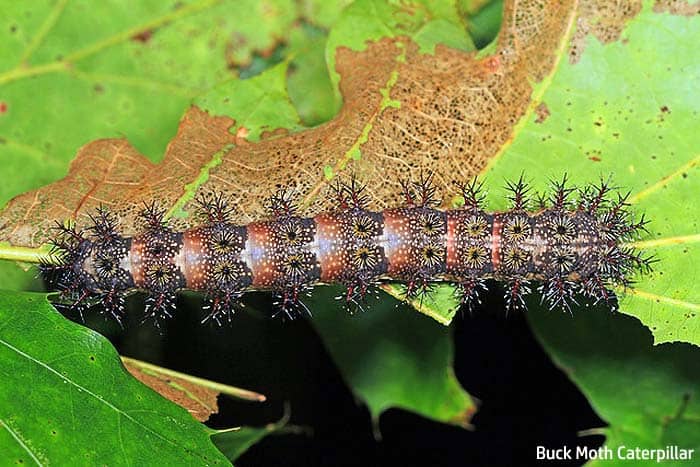
| Kingdom | Order | Family | Genus | Species |
|---|---|---|---|---|
| Animalia | Lepidoptera | Saturniidae | Hemileuca | Hemileuca maia |
The first poisonous caterpillar on our list is the Buck moth caterpillar. These caterpillars can be seen in most states of the Southeastern US
- These harmful caterpillars have black bodies with distinct white spots.
- There is a light form of the species that has a body with a greenish coloring and more prominent spots that look like starfish.
- The head and limbs called prolegs are red.
- Multiple, thin, branching spines cover the body.
- These venomous caterpillars usually come out around July, and the adult moths fly out in autumn.
- These poisonous caterpillars prefer to eat oak leaves but can also dine on willow, hazelnut, cherry, rose, and grasses.
- The breakable spines on the caterpillar’s body carry a poison that can cause reactions from simple rash or swelling to severe shock.
- This species is a part of the giant silkworm moths family, which also contains big, beautiful butterflies beloved by collectors.
![]()
Saddleback Caterpillar (Poisonous)
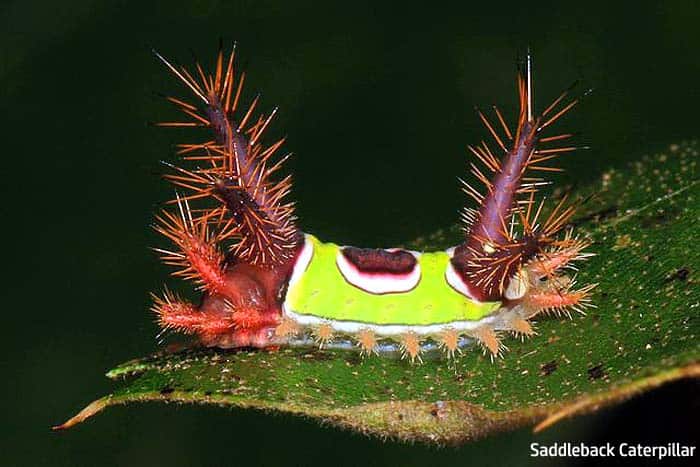
| Kingdom | Order | Family | Genus | Species |
|---|---|---|---|---|
| Animalia | Lepidoptera | Limacodidae | Acharia | Acharia stimulea |
These unique, slug-like poisonous caterpillars can be found in the Eastern United States.
- Saddleback caterpillar has a small, stocky body and resembles a slug.
- The Primary body color of this poisonous caterpillar is brown, with a distinct, bright green marking in the middle of the body, with an oval-shaped reddish mark in the middle that resembles a saddle.
- You can quickly notice two stocky, thick thorns on both head and tail covered with spines.
- Saddlebacks hatch from the eggs in spring and late winter (February-March), as they need around 5 months to grow and turn into a butterfly entirely;
- These deadly caterpillars are universal feeders and can eat leaves of multiple types of trees, including maple, oak, palms, and chestnuts.
- This venomous caterpillar has a potent poison that destroys blood cells. Even a small prick from the poisonous spine can cause asthma, stomachache, and bleeding.
- When attacked, the saddleback tries to shorten its stocky body as much as possible, putting the blackthorns with spine forward.
- The moth of this caterpillar is wholly unremarkable and is painted in mottled brown.
![]()
Monkey Slug Caterpillar/Hag Moth Caterpillar (Poisonous)
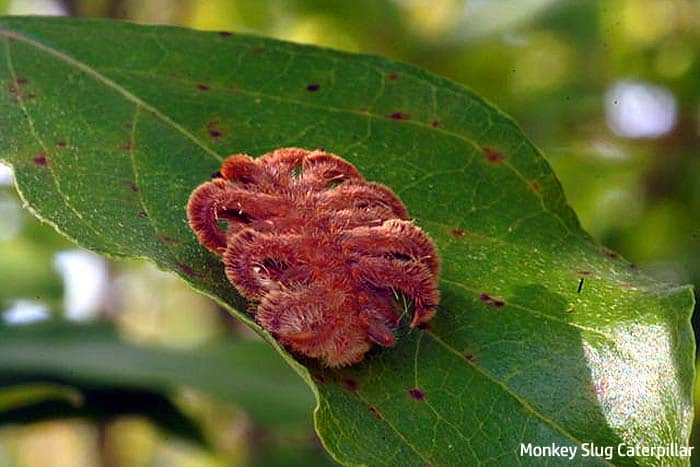
| Kingdom | Order | Family | Genus | Species |
|---|---|---|---|---|
| Animalia | Lepidoptera | Limacodidae | Phobetron | Phobetron pithecium |
The butterflies of this species usually reside in the Eastern States of the USA
- The so-called “monkey caterpillar” has a short, stocky body with nine pairs of bendable “arms” covered in brown, thin hair.
- This poisonous caterpillar usually feeds on the underside of the leaves and relies on suction cups to hold on.
- These slug-like critters usually hatch in the spring.
- Unlike real monkeys, these creatures are not picky about food and can be found on leaves of different trees, from oak and elm to apple and cherry.
- The poison of the hair is mild and causes allergic reactions only in particularly sensitive people.
- While the caterpillar itself is called “monkey slug, the adult moth is named “hag moth,” though it is instead an ordinary-looking insect with yellowish wings that has nothing nightmarish about its appearance.
![]()
Hickory Tussock Caterpillar (Poisonous)
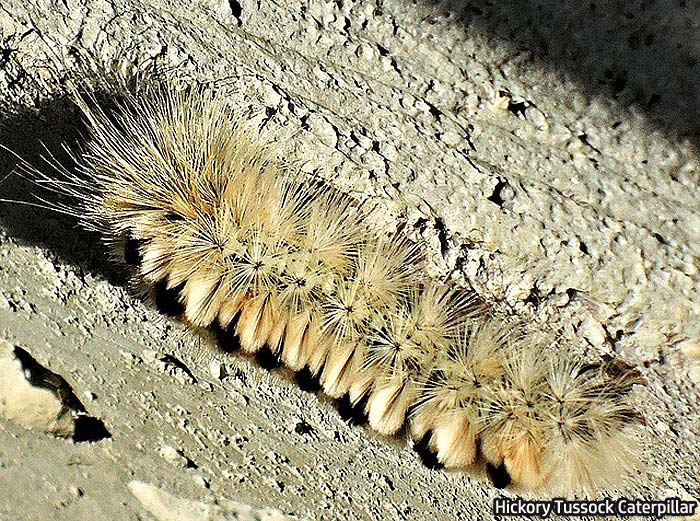
| Kingdom | Order | Family | Genus | Species |
|---|---|---|---|---|
| Animalia | Lepidoptera | Erebidae | Lophocampa | Lophocampa caryae |
The next poisonous caterpillar on our list is the Hickory tussock caterpillar. These are native to Southern Ontario, Canada.
- The body of this caterpillar is painted in black and white: The primary color of the body is white, with thin hair on the sides. There are connected black markings in the middle of the back.
- The front and the rear of the caterpillar’s body are covered with long, black hair that contains poison.
- A prick from the poisonous hair results in a rash or a swelling similar to poison ivy.
- People sensitive to the tussock caterpillar poison may develop severe allergic reactions or feel nauseous.
- The black & white caterpillars are specific feeders and prefer hickory, walnut, elm, and oak leaves.
- It is better to be wary of these black and white fuzzy caterpillars from July to September when they actively roam and feed.
![]()
Southern Flannel Moth Caterpillar or Puss Caterpillar (Poisonous)
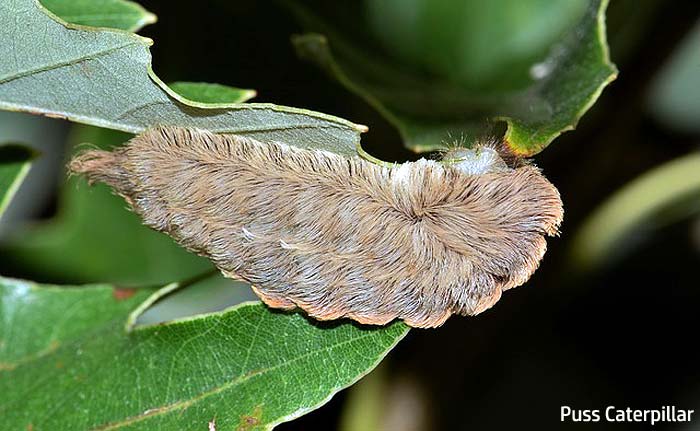
| Kingdom | Order | Family | Genus | Species |
|---|---|---|---|---|
| Animalia | Lepidoptera | Megalopygidae | Megalopyge | Megalopyge opercilaris |
The puss caterpillar is widespread in the Southern States, including New Jersey, Arkansas, Florida, and Texas.
- The young caterpillars look ordinary – small, thin, yellow, and covered with hairs sticking from the sides.
- These Florida caterpillars, at the last stages of growth, have a slug-like tiny body covered with many orange or bright yellow hairs that resemble fur.
- The poison of the mature caterpillar is highly dangerous and can destroy blood cells.
- People who touch the animal usually feel the burning pain immediately, followed by a rash that looks like an imprint of the spines.
- Then, the people may develop bleeding, difficulty breathing, and other dangerous symptoms.
- There were reports when schools were closed in Texas due to the abundance of puss caterpillars. These insects prefer oak and citrus trees that often grow near schools and kindergartens, and children often try to grab them.
![]()
Spiny Oak Slug Moth Caterpillar (Venomous)
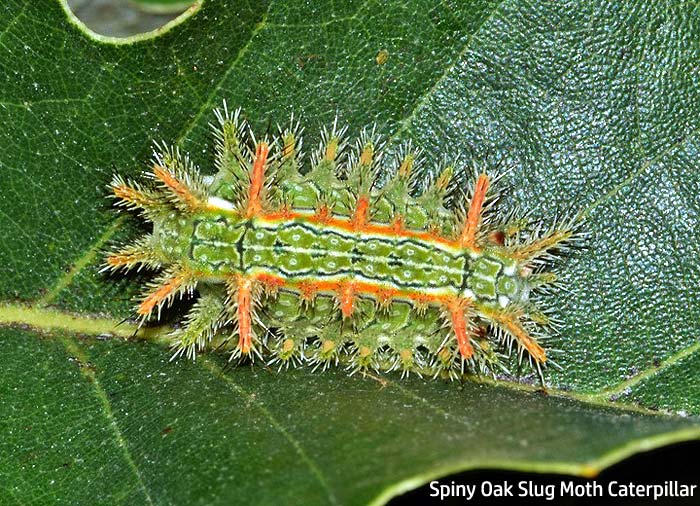
| Kingdom | Order | Family | Genus | Species |
|---|---|---|---|---|
| Animalia | Lepidoptera | Limacodidae | Euclea | Euclea delphinii |
Spiny oat slug moth caterpillars are the next poisonous caterpillars on our list. They live in most eastern states in the US up to the northern areas of Ontario, Canada.
- These stinging caterpillars can appear twice a year in warmer areas and only once a year in spring in colder ones.
- This caterpillar is more conventional. The body can be light green, yellow, reddish, or orange.
- This venomous yellow caterpillar feeds on oak leaves exclusively.
- The body of the spiny oak slug moth is covered with dense branching horn-like structures with tiny short spines on them, resembling holly trees.
- The spine’s poison causes mild allergies.
![]()
Io Moth Caterpillar (Venomous)
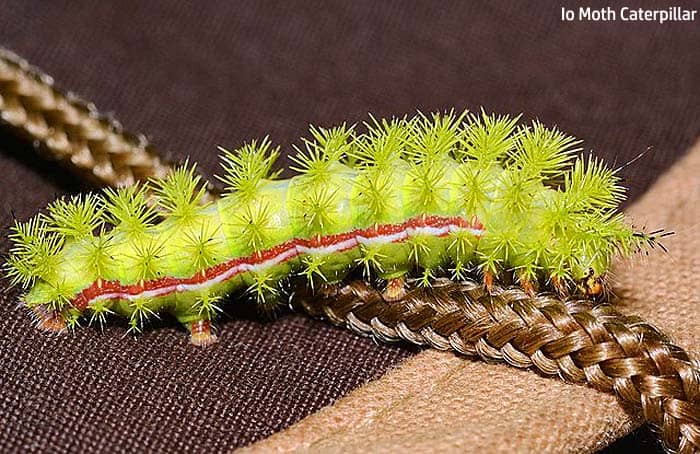
| Kingdom | Order | Family | Genus | Species |
|---|---|---|---|---|
| Animalia | Lepidoptera | Saturniidae | Automeris | Automeris io |
Io moth butterflies and their caterpillars can be found in Cape Cod and Massachusetts, sometimes in the Gulf States and New England.
- As they grow, the caterpillars change their color from reddish brown with black spines to light green with reddish-white stripes.
- The spines of the Io moth caterpillar are arranged in distinct “bouquets“.
- This stinging caterpillar is not a picky eater and feeds on many types of trees – maples, cherries, birches, and even cranberry and gooseberry plants.
- The spines arranged in “bunches” are mildly poisonous. Usually, it causes allergic reactions.
- The moth of this species is usually active in the afternoon and evening and has distinct “eyes” on the lower wings.
![]()
White Flannel Moth Caterpillar (Poisonous)
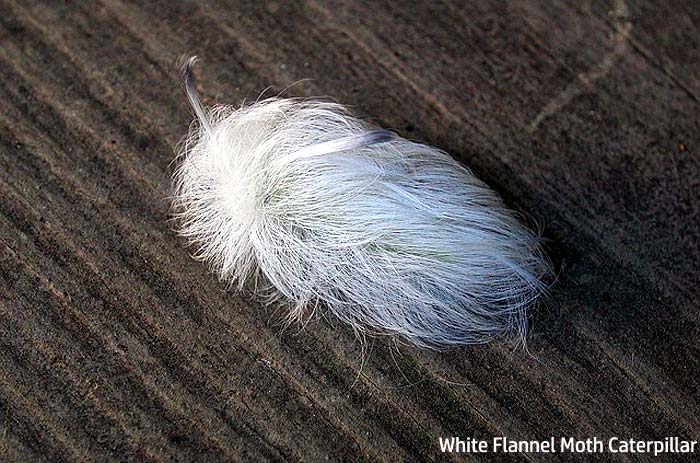
| Kingdom | Order | Family | Genus | Species |
|---|---|---|---|---|
| Animalia | Lepidoptera | Megalopygidae | Norape | Norape ovina |
A relative of the southern flannel moth caterpillar, this poisonous caterpillar can be found in Lousiana, Mississippi, Alabama, and Tennessee.
- Unlike its more famous relative, the white flannel moth caterpillar has a dark-colored, small body with round, yellow-colored patches.
- There are puffs of stinging black hair on the back.
- The head and tail of the caterpillar are orange, in contrast to the rest of the body.
- White flannel moth caterpillar possesses stinging hair that causes pain, sometimes allergy, and swelling.
- Another distinct feature of the white flannel moth caterpillar is a chain of natural black triangle markings between the bright yellow spots.
- This poisonous yellow caterpillar prefers hackberry, black locust, and redbud.
![]()
Stinging Rose Caterpillar (Venomous)
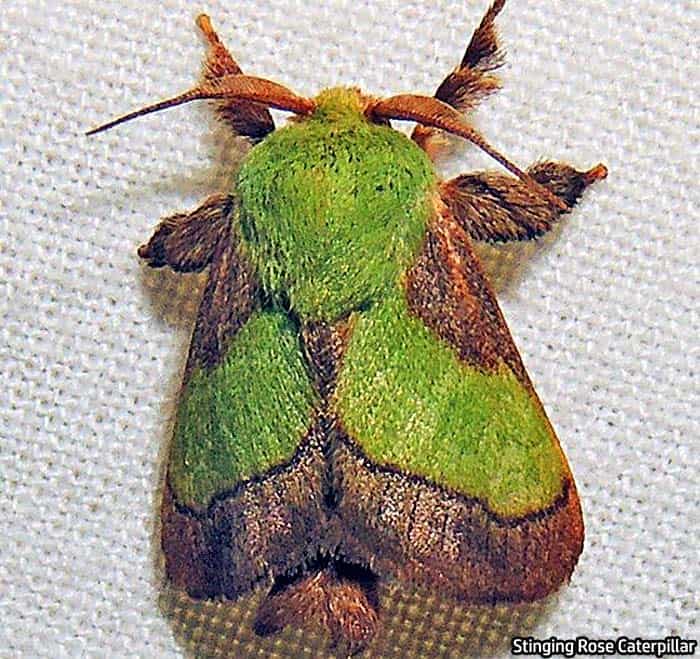
| Kingdom | Order | Family | Genus | Species |
|---|---|---|---|---|
| Animalia | Lepidoptera | Limacodidae | Parasa | Parasa indetermina |
This peculiar poisonous caterpillar lives in many States west of Texas and Oklahoma, including Florida, New York, Philadelphia, and Illinois.
- The appearance of the stinging rose is very striking: the caterpillar has a bright yellow or orange body with a signature purple stripe running along the back. There are also reddish lines on either side of the caterpillar’s body.
- The poison is contained in the stocky yellow horn-like structures with smaller and thinner spines that cover the body.
- You risk encountering these spines almost everywhere, as this stinging caterpillar can be found on rose bushes, maples, oaks, poplars, dogwood, and hickory.
- The poison mainly causes allergic reactions, which can be severe in sensitive people and mild for others.
![]()
American Dagger Caterpillar (Poisonous)
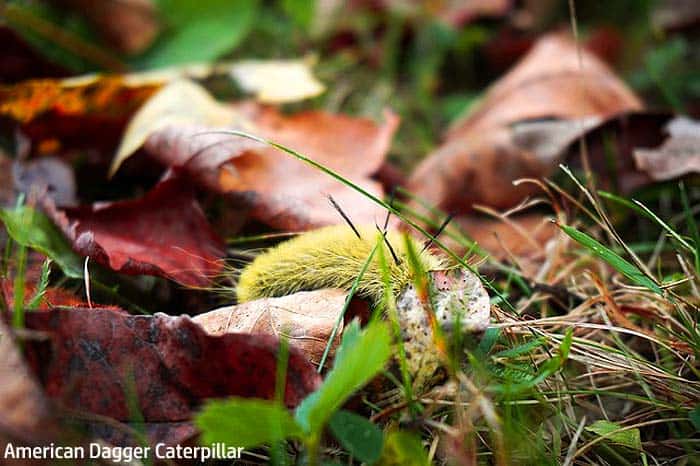
| Kingdom | Order | Family | Genus | Species |
|---|---|---|---|---|
| Animalia | Lepidoptera | Noctuidae | Acronicta | Acronicta americana |
This species is truly American – it can be found throughout Eastern North America.
- The body of the American dagger moth caterpillar is short and covered with thin, long green hair.
- Thin, long black spines protrude among the fur-like hair, forming a whole bunch on the rear end.
- The thick black spine-like hair is the source of the poison that can cause a painful rash.
- The spiky green caterpillar feeds on most common forest trees, such as oak, ash, and elm.
- Is American dagger moth caterpillar poisonous to humans? Of course, it is. Some people can find them on the ground – do NOT pick them up without gloves!
![]()
Smeared Dagger Moth (Poisonous)
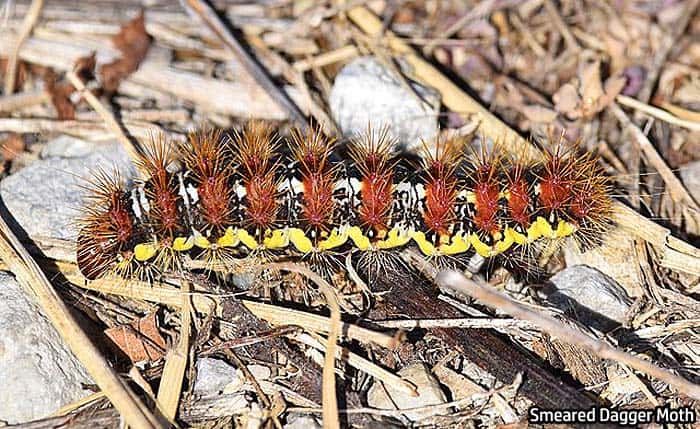
| Kingdom | Order | Family | Genus | Species |
|---|---|---|---|---|
| Animalia | Lepidoptera | Noctuidae | Acronicta | Acronicta oblinita |
Another member of the dagger moth family, this poisonous caterpillar, also lives in Eastern North America.
- The caterpillar’s body is black with bright yellow side stripes.
- Smeared dagger moth caterpillar also has stinging hair that causes severe pain, allergy, and swelling.
- The back of the caterpillar is adorned with bunches of thin, white bristles, reddish at the base.
- The Smeared dagger moth caterpillar can feed on anything from grasses to fruit trees.
![]()
Laurelcherry Smoky Moth (Poisonous)

| Kingdom | Order | Family | Genus | Species |
|---|---|---|---|---|
| Animalia | Lepidoptera | Zygaenidae | Neoprocris | Neoprocris floridana |
This mildly poisonous caterpillar lives in Florida.
- This species prefers Carolina laurel cherry to anything else.
- This caterpillar’s short and stocky body is transparent yellow on the sides, with intermittent black stripes.
- The danger comes from the small, yellowish hair covering the body.
- The hair stings – the victim first feels pain, then a rash develops on the skin, followed by blisters.
- This caterpillar also has a small hood that can hide his head when necessary.
![]()
Variable Oakleaf Caterpillar (Poisonous)
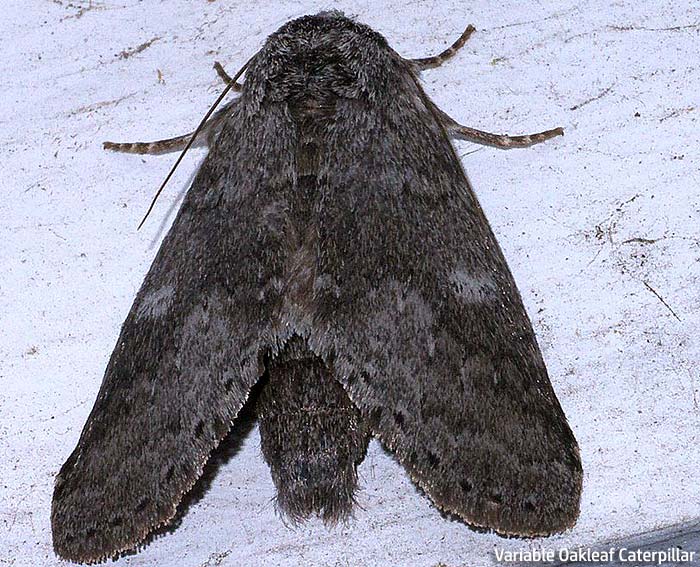
| Kingdom | Order | Family | Genus | Species |
|---|---|---|---|---|
| Animalia | Lepidoptera | Notodontidae | Lochmaeus | Lochmaeus manteo |
This poisonous caterpillar is another resident of Eastern North America.
- As the name suggests, the caterpillar is almost exclusive to oaks.
- If you wish to meet the species – wait for July or August.
- It has earned the name “variable” because it can have different markings on its long, lanky body.
- The only universal feature is the distinct reddish stripe on the back.
- Even if there are different variations, the main colors the caterpillar wears are red and green.
- Instead of poisonous spines, this caterpillar produces formic acid that stings and can cause allergy.
Moreover, now let us introduce you to two unique representatives of butterflies and moths that live outside the US.
![]()
Pine Processionary Caterpillar (Poisonous)
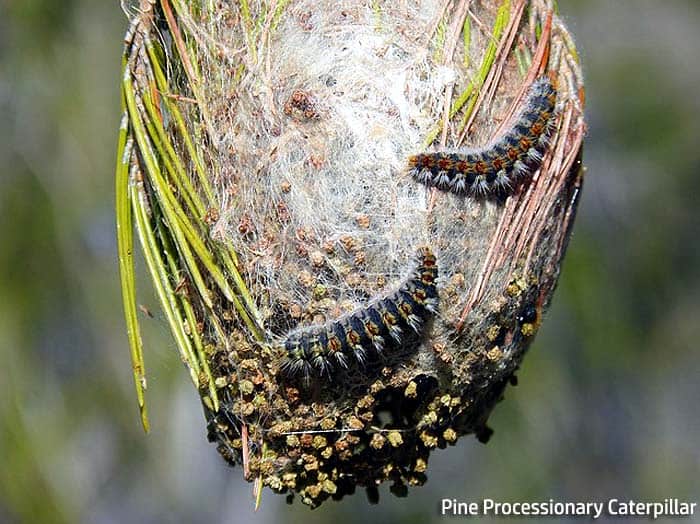
| Kingdom | Order | Family | Genus | Species |
|---|---|---|---|---|
| Animalia | Lepidoptera | Thaumetopoeidae | Thaumetopoea | Thaumetopoea pityocampa |
The next poisonous caterpillar lives in Southern Europe.
- These caterpillars of this species are social: they form colonies that travel together from tree to tree.
- The caterpillar’s body is colored green with yellow stripes and is covered with thin, whitish spines.
- This caterpillar feeds exclusively on pine needles; each colony settles on a pine branch and makes a nest of silk threads.
- The spines can cause only a mild allergy in humans, but they are dangerous for pets, especially dogs.
- Tourists visiting France and Spain are advised to keep their dogs from the processions of caterpillars and to avoid standing under pines in summer, especially if there are caterpillar nests.
![]()
Giant Silkworm Moth Caterpillar (Poisonous)
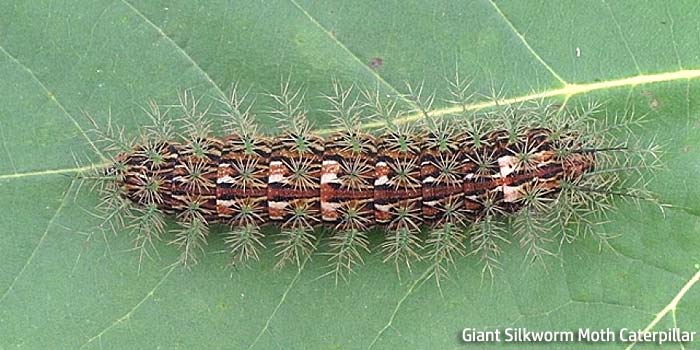
| Kingdom | Order | Family | Genus | Species |
|---|---|---|---|---|
| Animalia | Lepidoptera | Saturniidae | Lonomia | Lonomia obliqua |
The last poisonous giant silkworm moth caterpillar is a Brazilian citizen and prefers rainforests.
- The color pattern of the giant silkworm caterpillar is not particularly remarkable – mostly brown and green, with a striped pattern.
- The whole body of the caterpillar is covered with thin white spines with multiple branches. The endings of the branches are colored black.
- The venom of this caterpillar can prevent the blood from clotting, causing bleeding and destruction of the body from within.
- Medics worldwide actively study this venom because it can help treat some heart diseases because of its ability to dissolve blood clots.
- These caterpillars are guardians: monkeys or other animals do not damage the trees where the giant silkworms reside. This way, the trees get high-class protection for the price of a few leaves.
![]()
Does a caterpillar being poisonous really help it?
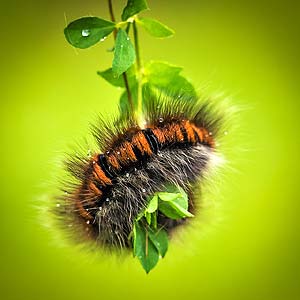
There are many poisonous caterpillars, as you can see. However, it does not mean the poison fully protects them.
- The birds that desperately need protein so that the caterpillars can find their way.
- Some eat caterpillars when they are very young and have weak poison.
- Others develop a resistance to a particular poison that the caterpillars use.
- Of course, giant silkworms are the exception – no known animal can stand up to them.
Suggested Reading:
Top 10 Poisonous Birds
![]()
In conclusion – if you see a bright-colored, fluffy caterpillar with suspicious horns or spines – avoid them at all costs. If you must remove them – use protection. Many species pretend to be poisonous, but it is still better to be safe.
![]()


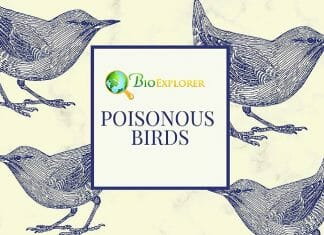

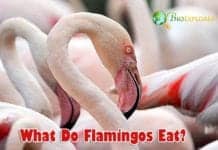

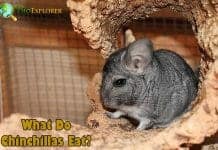












Good work. I have the remedy, in fact, quicker remedy for caterpillar stings.